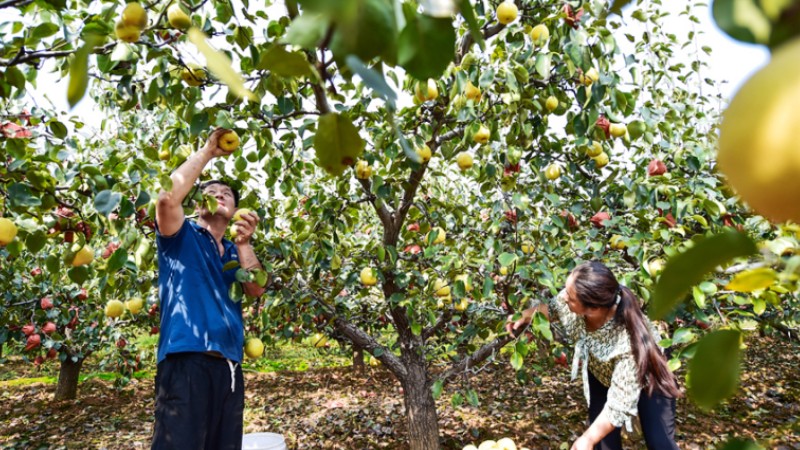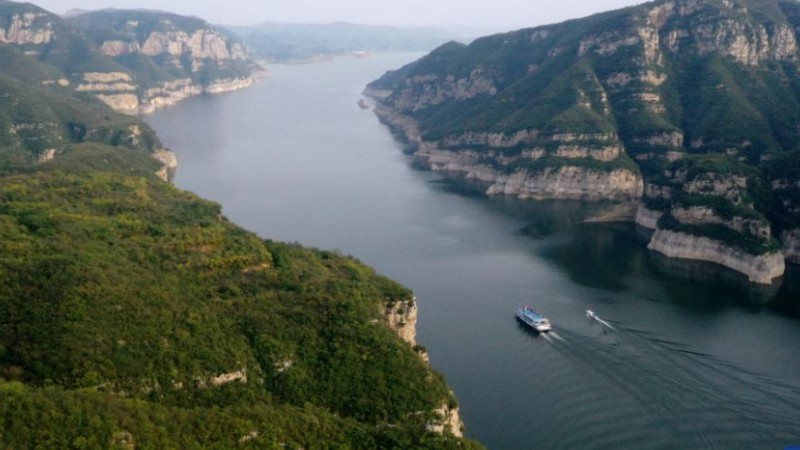A Commitment Across the Ocean - A Snapshot of High-Quality Belt and Road Cooperation Between China and Latin America and the Caribbean
During my flight to Panama for a working visit not long ago, I looked out the window and saw cargo ships line up by the locks on the Panama Canal to pass between the oceans. Every year, vessels crossing the Canal ship over 500 million tons of cargo around the world, a vivid demonstration of the meaning of “connectivity.” The scene brings to mind the China Ships traversing the maritime Silk Road more than 500 years ago. It also reminds me that Panama became the first Latin American and Caribbean (LAC) country that joined the Belt and Road Initiative (BRI) in November 2017, only five months after establishing diplomatic relations with China, which reflects the great appeal of the BRI.
President Xi Jinping put forward the BRI in 2013. The initiative has since been widely welcomed by the international community. Many LAC countries have expressed strong desire for participation. When meeting with LAC leaders, President Xi Jinping highlighted that Latin America and the Caribbean are “a natural extension of the 21st Century Maritime Silk Road.” In January 2018, the second ministerial meeting of the China-CELAC Forum held in Chile released a special declaration on the BRI, marking the extension of the BRI to Latin America and the Caribbean across the board. With Honduras joining the BRI in June this year, there are now 22 LAC countries, all important and indispensable, participating in the initiative. Despite the geographical distance across the Pacific Ocean, China and Latin America and the Caribbean have translated their shared commitment to high-quality Belt and Road cooperation into a close-knit “belt to development” and a solid “road to happiness” for both sides as envisioned.
Policy connectivity—“We benefit from China’s development experience (in our cooperation).” This is the shared assessment by experts from Argentina, Cuba and other countries. This year marks the 63rd anniversary of China’s diplomatic relations with Latin America and the Caribbean. Over the years, China has all along treated LAC countries as equals and maintained close exchanges with them. In the past decade, President Xi Jinping has visited the LAC region five times, personally charting the course for the development of the bilateral relations and Belt and Road cooperation. President Xi Jinping has said on many occasions that the pursuit of the BRI is not meant to reinvent the wheel. Rather, it aims to enhance the synergy among the development strategies of the partner countries and draw on each other’s comparative strengths. Under the guidance of Xi Jinping Thought on Socialism with Chinese Characteristics for the New Era and Xi Jinping Thought on Diplomacy, China has followed the principle of sincerity, real results, amity and good faith and the right approach to friendship and interests, strengthened solidarity and cooperation with countries in the region, shared its development experience, and made sound top-level plans for jointly taking Belt and Road cooperation forward.
During Venezuelan President Nicolás Maduro’s visit to China in September this year, he visited China’s special economic zone to draw experience for devising his country’s development strategy. In recent years, the BRI has formed synergy with Chile’s Digital 2035 strategy, Panama’s National Logistics Strategy for 2030, Uruguay’s National Infrastructure Plan, Trinidad and Tobago’s diversification development strategy, among others, contributing positively to the countries’ efforts to overcome development bottlenecks, foster growth drivers and achieve sustainable development.
Infrastructure connectivity—“The Chinese are doing what some other country chose not to do in several hundred years.” This is the comment of Jamaican British rapper Akala on the infrastructure cooperation between China and Latin America and the Caribbean. Infrastructure is the cornerstone of connectivity, yet it is also a bottleneck the LAC region faces in its development. Preliminary figures show that by September 2023, China had implemented more than 200 infrastructure projects in the region, including building several thousand kilometers of road, railway and light rail, more than 100 schools, hospitals and stadiums, some 100 bridges and tunnels, dozens of airports and ports, and more than 30 power stations, plants and other power facilities, creating nearly one million local jobs. In this process, with one highlight after another in digital, green and new infrastructure cooperation, LAC countries’ own capacity for development is growing. With more favorable infrastructure development conditions, these countries are better positioned to integrate into the global supply, industrial and value chains.
We are happy to see that the Eloy Alfaro International Airport in Ecuador, rebuilt after earthquake, has become an important channel connecting the country and the world; the redeveloped St. John’s Harbor in Antigua and Barbuda will help the country become a regional shipping hub; the Phoenix Park Industrial Estate in Trinidad and Tobago, upon completion, will become the most intelligent and automated logistics platform in the Caribbean region; The Nestor Kirchner-Jorge Cepernic Hydroelectric Power Plant in Argentina, the world’s southernmost hydropower station, will, when completed, save the country a huge amount of spending on oil and gas import, and make Argentina a power exporter; the Jamaica North-South Highway is hailed as a runway to “a brighter, more prosperous future for Jamaica”; the Talca-Chillán section of Route 5 in Chile is acclaimed by the Chilean people as a road to prosperity built by their Chinese friends.
Trade connectivity—One of the farthest countries has become one of China’s biggest sources of fruit imports. Thanks to the benefit of free trade, Chile, one of the countries farthest away from China, has become the country’s second largest source of fresh fruits. But that is not the only pleasant surprise. Over the past 10 years, trade in goods between China and LAC countries nearly doubled, up from USD 261.6 billion in 2013 to USD 485.8 billion in 2022. China stayed the second largest trading partner of LAC and the top trading partner of Brazil, Chile, Peru and Uruguay, among others. Even during COVID-19, China-LAC trade kept growing, a sign of strong complementarity and resilience. I am delighted to see shielding plugs made by Combustibles Nucleares Argentinos (Conuar) be used in Chinese nuclear power plants for the first time in September. This is another example of the diversification in LAC’s exports to China. Meanwhile, trade in services between the two sides registered many highlights. At the China International Fair for Trade in Services that just took place this year, LAC countries sent a cohort of exhibitors to the event. Special tour packages featuring Cuba, Mexico, Peru, Argentina and other countries were a big hit, and LAC’s cooperation with China in such areas as sports training, knowledge economy, culture and entertainment continued to expand.
It is worth noting that the surge in China-LAC trade is due in large measure to the conclusion of successive free trade arrangements between the two sides. In 2023, China signed FTA agreements with Ecuador and Nicaragua; this brings the number of China’s free trade partners in the region to five on top of Chile, Peru and Costa Rica. What’s more, China and Honduras have launched and held the second round of FTA negotiations, and China and Peru have held the fifth round of negotiations on their FTA upgrade. Going forward, China’s door will only open wider, and China-LAC trade will yield more fruits.
Financial connectivity—“I would obviously like to thank the Chinese government.” This was the public expression of gratitude from Argentine Minister of Economy Sergio Massa when China provided bridge financing in RMB in July to help his country avert another debt default. As President Xi Jinping noted, “Finance is the lifeblood of modern economy.” Only when blood keeps pumping in, can growth be robust. In recent years, China has been doing its best to provide financing support for the economic and social development in LAC countries. China now stands as the region’s third biggest source of foreign investment. As of the end of 2021, the stock of Chinese FDI in the LAC countries approached USD 700 billion. With the establishment of the China-LAC Cooperation Fund, China-LAC Industrial Cooperation Investment Fund and China-LAC Development Financial Institutions Association, financing mechanisms between the two sides have become more full-fledged and financing channels more diversified. China’s investment and financing in LAC have no political strings attached, but aim to facilitate local development; they will not bring any debt trap, but impetus for development.
In recent years, RMB clearing banks have been set up in Chile, Brazil and Argentina, and countries such as Argentina and Bolivia announced the use of RMB for trade settlement. Late last year, RMB overtook euro to become Brazil’s second largest reserve currency. Experts from a number of regional countries pointed out that settlement in RMB helps reduce costs from currency exchange, lower exposure to financial sanctions and improve trade efficiency and security, thus offering a new alternative to countries of the Global South to enhance financial diversification and independence of their monetary policies.
People-to-people connectivity—“Wherever a project is built, it should serve as a monument of friendship between us.” This is President Xi Jinping’s hope for China-LAC cooperation that it can bring concrete, tangible benefits and real gains to the people on both sides. In recent years, there is a growing interest about China among LAC countries and about LAC in China. Cultural events such as the China-LAC Year of Culture Exchange, Dialogue Between the Civilizations of China and Latin America and the Caribbean, LAC-themed cultural festivals, culture exchange weeks, movie shows as well as Chinese and LAC TV series, music and dance are increasingly becoming part of our everyday life, and travel and studying in each other’s countries have enriched our life experience. Indeed, China-LAC friendship has benefited our people in so many ways. I am glad to learn that the Chinese Spring Festival has become a national holiday in several LAC countries. Today, more than 120 universities in China offer degrees of the Spanish language and nearly 40 of the Portuguese language; close to 60 academic institutions and colleges have centers dedicated to the LAC region or country-specific studies. Moreover, China has opened 47 Confucius Institutes and five Confucius Classrooms in 25 LAC countries.
Cooperation is truly beneficial when it delivers for everyone. During my trip to Dominica last July, I took time to visit the Chinese Agricultural Mission there. Mr. Sun Haojie, head of the Chinese expert team, has brought his family with him and worked in the country for 18 years. Together with his teammates, they made remarkable contributions to agricultural modernization in Dominica, and literally sowed the seeds of China-Dominica friendship in the hearts of the local people. Their dedication was recognized in the “Outstanding Achievement Award” granted by the Dominican government to the Mission. During my trip, I also had the opportunity to attend the launching ceremony of the Cardiovascular Imaging Center at the China-Dominica Friendship Hospital, another milestone in the bilateral healthcare cooperation. Prime Minister Roosevelt Skerrit led all his cabinet members and MPs from the ruling party to the ceremony, and expressed sincere gratitude to the Chinese people for the deep friendship. Apart from just giving people fish, China helps people learn how to fish. To date, China has sent nearly 30 batches of medical teams to Guyana, Dominica, and Barbados, among other countries. These medical teams have created many “firsts” in local medical practices and helped train a large number of local professionals for healthcare services.
When COVID-19 struck, China sent its doctors to Venezuela and Peru. While some Western developed countries hoarded vaccines and anti-pandemic supplies for themselves, China made its best effort to donate nearly 40 million items of medical supplies and equipment to 30 LAC countries, and provided 400 million doses of vaccines to 22 countries in the region. In return, when the U.S.-led West engaged in relentless smearing of China, many leaders from the region spoke up for China, and the governments and people of many LAC countries donated medical supplies to the Chinese people. These and many other facts have shown time and again that China and LAC are truly trustworthy friends. Our vision to build a China-LAC community with a shared future enjoys strong public support and is built on a solid track record of concrete practices.
In a few days time, representatives from many LAC countries will come to Beijing for the third Belt and Road Forum for International Cooperation. This is a vote of satisfaction about and confidence in China-LAC high-quality Belt and Road cooperation. We look forward to having more LAC countries joining the Belt and Road family, and we are confident that our high-quality Belt and Road cooperation will bear more fruits and deliver more benefits for people on both sides.
The author is Assistant Minister of Foreign Affairs of the People’s Republic of China.
Photos
Related Stories
- Interview: BRI boosts cooperation, integration in Carribean, says expert
- BRI deepens cooperation in various fields between ASEAN and China, says Thai expert
- Interview: BRI brings unlimited opportunities to Hong Kong, says Belt and Road commissioner
- China's technologies help BRI partners turn waste into wealth
- Interview: China's BRI boosts infrastructure connectivity, green development: Cambodian scholar
- Feature: BRI opens window for Greece, the world: painter
- China's Luban Workshop helps foster skilled workforce in Thailand
- Small projects for greater prosperity
- Inspirational tour across China: Tanzanian officer commends BRI for promoting global cooperation and connectivity
- Interview: 3rd Belt and Road Forum for Int'l Cooperation will add positive energy, stability to world: vice FM
Copyright © 2023 People's Daily Online. All Rights Reserved.









